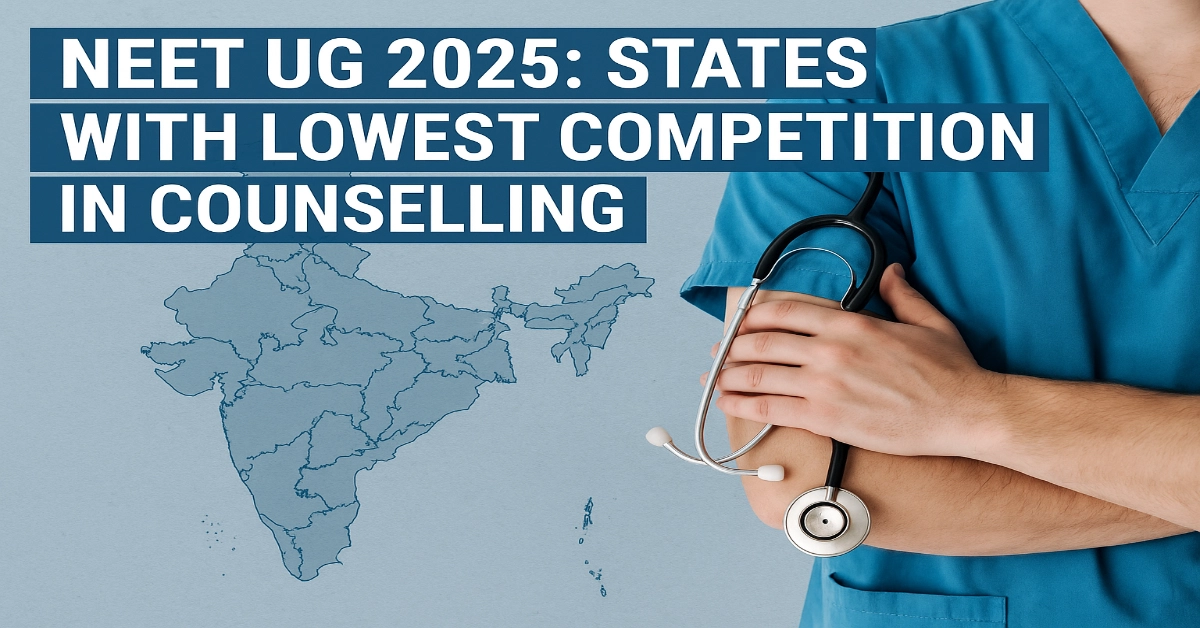As NEET UG 2025 results are just a few weeks away, lakhs of aspiring doctors are preparing for the next crucial step, counselling. One of the most common questions among students and parents is: “Which state has the lowest competition in NEET UG counselling?”
While there’s no officially declared “low competition” state, trends from previous years, the number of medical seats, and cut-off scores give us important insights. Let’s explore this in detail.
What Does “Low Competition State” Mean?
In simple terms, a low competition state is one where:
| NEET UG Counselling Guide 2025 | |
|---|---|
| State-wise MBBS/BDS Counselling Guide eBook 2025 | 📥 Download |
| MCC NEET UG Counselling Guide eBook 2025 | 📥 Download |
| AACCC AYUSH NEET Counselling Guide eBook 2025 | 📥 Download |
- The number of available MBBS/BDS seats is high compared to the number of candidates applying.
- The cutoff ranks or scores are relatively lower than other states.
- A higher percentage of students manage to secure government or private medical seats.
But determining such a state depends on many factors, including quota types, category reservations and seat distribution.
Understanding NEET UG Counselling: AIQ vs State Quota
To understand competition levels, you must first understand how NEET UG seats are divided:
1. All India Quota (AIQ) – 15% of total government seats
- Open to candidates from all states.
- Highly competitive, especially for general category students.
- Centralised counselling is conducted by the MCC (Medical Counselling Committee).
- AIQ seats are mostly taken by students with high NEET scores.
2. State Quota – 85% of total government seats
- Reserved for domicile candidates (residents of the respective state).
- Cutoff scores are often lower than AIQ, especially for reserved categories.
- Counselling is conducted by state authorities.
- Availability of seats and competition vary widely across states.
States with Relatively Low Competition (State-wise Details)
1. Telangana
- Why it’s favourable: It has a high number of government and private medical colleges.
- Competition level: Moderate.
- Seat availability: There are 35 medical colleges in Telangana, comprising 12 government and 23 private institutions. These colleges offer 5240 MBBS seats and 2237 postgraduate seats.
- Cutoff trend: State quota cutoffs are generally lower than high-demand states like UP or Karnataka.
- AIQ scene: Telangana government college AIQ cutoffs are moderate to high, but not as tough as Delhi or Tamil Nadu.
2. Madhya Pradesh
- Why it’s favourable: Fewer applicants compared to several seats; improving infrastructure.
- Seat availability: Madhya Pradesh has approximately 30-35 medical colleges. Of these, around 25-30 are private, and the remaining are government-run.
- Cutoff trend: MP State Quota cutoffs for government colleges are slightly lower than other northern states.
- AIQ data: AIQ ranks for MP colleges are mid-range, not as competitive as AIIMS or top-tier colleges.
3. Rajasthan
- Why it’s favourable: Decent number of seats, and several students migrate out of state.
- Seat availability: There are 34 medical colleges in Rajasthan offering MBBS courses. Out of these, 25 are government-run, and 9 are private.
- Cutoff trend: State quota cutoffs are moderate. Reserved category students often get admission with lower scores.
- AIQ data: AIQ cutoffs for top government colleges in Rajasthan are competitive but lower than Delhi or Maharashtra.
4. West Bengal
- Why it’s favourable: Balanced seat availability and a manageable number of NEET aspirants.
- Seat availability: West Bengal has a total of 35 medical colleges, comprising 12 government and 23 private institutions.
- Cutoff trend: State quota cutoff ranks are reasonable, especially for OBC/SC/ST candidates.
- AIQ data: Top colleges like Calcutta Medical College have competitive AIQ cutoffs, but the second-tier colleges are easier to access.
States with Very High Competition
These states often witness massive participation in NEET and have limited government seat availability. Cutoffs are very high.
- Uttar Pradesh: Large number of aspirants; competition is intense.
- Bihar: High number of NEET-qualified students, limited medical seats.
- Tamil Nadu: Excellent medical infrastructure, but extremely high competition.
- Karnataka: Popular for private colleges, but high demand raises cutoffs, especially under AIQ.
Why It’s Hard to Pinpoint One “Lowest Competition” State
Several dynamic factors make it hard to declare any one state as the lowest competition zone:
1. Cutoff Score Variations
- Cutoffs depend on seat numbers, category reservations, and exam difficulty.
- Some states may have lower cutoffs in one year and higher in the next.
2. Category-Based Admissions
- SC/ST/OBC candidates often benefit from lower cutoffs in many states.
- A state may appear to have low competition for one category, but not for others.
3. Exam Difficulty
- If NEET 2025 is tougher, overall cutoffs might fall.
- That can make admission possible at lower scores, even in previously high-cutoff states.
4. Migration Trends
- Students from high-competition states (like UP or Bihar) apply in other states through AIQ or private seat counselling, increasing competition elsewhere.
What Should You Do as a Candidate?
Here’s how to use this information smartly:
For State Quota
- Check if you’re eligible for domicile in a low-competition state.
- Review last year’s state quota cutoffs for your category.
- Consider Telangana, MP, Rajasthan, or West Bengal if you’re looking for less competition.
For All India Quota
- Aim for second-tier government colleges in states with moderate AIQ cutoffs.
- Do thorough research on last year’s AIQ closing ranks across multiple states.
Private and Deemed Colleges
- Explore options beyond government colleges if the budget allows.
- Some private colleges in low-demand states offer relatively affordable options.
There is no officially declared “lowest competition” state in NEET UG 2025. However, states like Telangana, Madhya Pradesh, Rajasthan, and West Bengal show favourable trends due to their seat availability and moderate cutoffs.
Instead of looking for shortcuts, aspirants should:
- Understand counselling processes clearly
- Analyse last year’s data carefully
- Apply smartly across all possible quotas and states
Read Also: State‑Wise Lowest NEET 2025 Cutoff for MBBS Admission in India!
Read Also: Top States Offering MBBS Seats at Low NEET UG 2025 Scores


